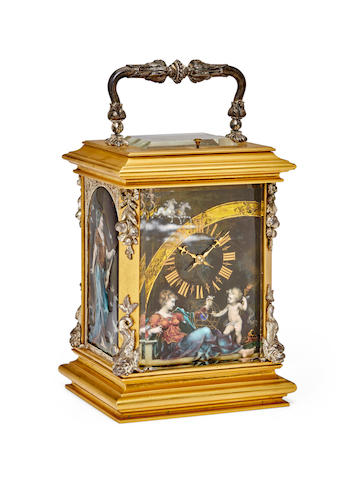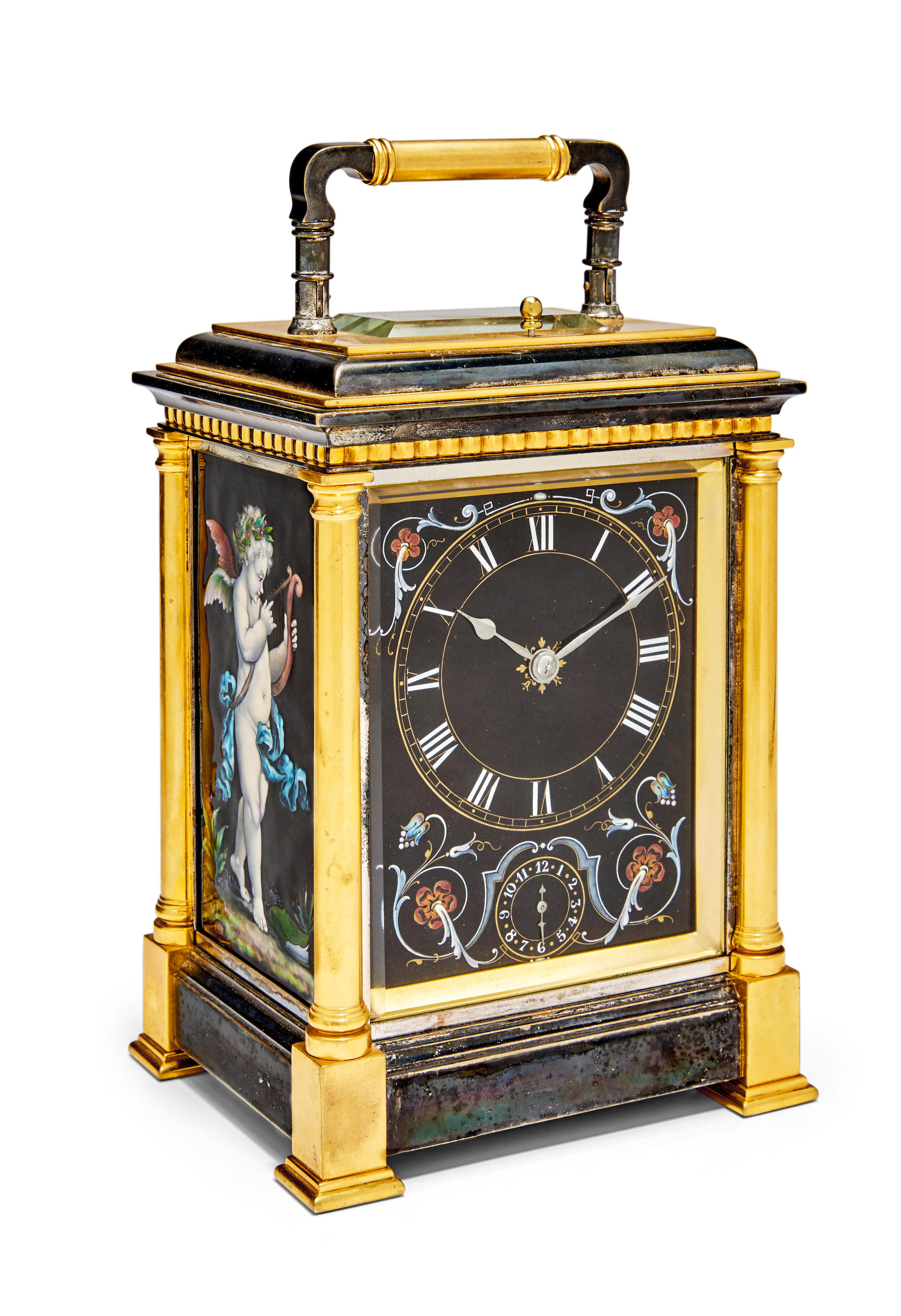A fine silvered and gilt brass grande-sonnerie striking cariatides carriage clock with push-button repeat and alarm Probably by Henry Jacot, Paris, late 19 th century The eight-day two train movement ting-tang striking the quarters on a graduated pair of gongs and sounding the hour every quarter hour on the larger of the two, with silvered platform lever escapement and alarm sounding on the smaller gong, the dial with rectangular silvered mask enclosing recessed circular white enamel disc with green line rosette centre within cartouche Roman numeral chapters and entwined scroll half hour markers, with blued steel spade hands over conforming subsidiary alarm setting dial to lower margin, the bevel-glazed frosted gilt break-arch cariatides case with hinged reeded carrying handle over thick curved top glass to pediment inset with a cast silvered laurel wreath to tympanum, The cornice with reeded band over, Classical female term applied canted angles, on conforming reeded band decorated ogee moulded base with stepped skirt, the underside with G de Sonnerie/Silence/P te Sonnerie selection lever, 18cm (7.25ins) high excluding handle. The current lot can be directly compared to an example attributed to Henry Jacot illustrated in Roberts, Derek CARRIAGE and other Travelling CLOCKS on page 107 (Fig. 6-44) where the design of the dial is noted as typical of his work . Another clock by Jacot in a case of identical form is illustrated in Allix, Charles and Bonnert, Peter CARRIAGE CLOCKS, Their history and development page 172 (Plate VII/24) as well as on the rear of the dust jacket. Henry Jacot is recorded in Allix, Charles and Bonnert, Peter CARRIAGE CLOCKS, Their history and development as working from 31 Rue de Montmorency, Paris as well as possibly having a factory in Saint-Nicolas-d Aliermont. The business was awarded Bronze Medals at the Paris Exposition in 1855 and in London 1862; Silver in Paris 1867, 78 and 89 and Gold, again in Paris, 1890. Henri Jacot senior died in 1868 and was succeeded by his nephew of the same name. The business is thought to have continued until around 1920. As an addendum to the above footnote the information provided by Allix and Bonnert relating to the business being succeeded by Henri s nephew of the same name is incorrect. Research undertaken by Leigh Extence has revealed that after his death in 1868, Henri's business was continued by his brother Julien who was actually only 'keeping the bench warm' until his son, and Henri's nephew Albert, was able to take over and move the concern forward in 1874.
A fine silvered and gilt brass grande-sonnerie striking cariatides carriage clock with push-button repeat and alarm Probably by Henry Jacot, Paris, late 19 th century The eight-day two train movement ting-tang striking the quarters on a graduated pair of gongs and sounding the hour every quarter hour on the larger of the two, with silvered platform lever escapement and alarm sounding on the smaller gong, the dial with rectangular silvered mask enclosing recessed circular white enamel disc with green line rosette centre within cartouche Roman numeral chapters and entwined scroll half hour markers, with blued steel spade hands over conforming subsidiary alarm setting dial to lower margin, the bevel-glazed frosted gilt break-arch cariatides case with hinged reeded carrying handle over thick curved top glass to pediment inset with a cast silvered laurel wreath to tympanum, The cornice with reeded band over, Classical female term applied canted angles, on conforming reeded band decorated ogee moulded base with stepped skirt, the underside with G de Sonnerie/Silence/P te Sonnerie selection lever, 18cm (7.25ins) high excluding handle. The current lot can be directly compared to an example attributed to Henry Jacot illustrated in Roberts, Derek CARRIAGE and other Travelling CLOCKS on page 107 (Fig. 6-44) where the design of the dial is noted as typical of his work . Another clock by Jacot in a case of identical form is illustrated in Allix, Charles and Bonnert, Peter CARRIAGE CLOCKS, Their history and development page 172 (Plate VII/24) as well as on the rear of the dust jacket. Henry Jacot is recorded in Allix, Charles and Bonnert, Peter CARRIAGE CLOCKS, Their history and development as working from 31 Rue de Montmorency, Paris as well as possibly having a factory in Saint-Nicolas-d Aliermont. The business was awarded Bronze Medals at the Paris Exposition in 1855 and in London 1862; Silver in Paris 1867, 78 and 89 and Gold, again in Paris, 1890. Henri Jacot senior died in 1868 and was succeeded by his nephew of the same name. The business is thought to have continued until around 1920. As an addendum to the above footnote the information provided by Allix and Bonnert relating to the business being succeeded by Henri s nephew of the same name is incorrect. Research undertaken by Leigh Extence has revealed that after his death in 1868, Henri's business was continued by his brother Julien who was actually only 'keeping the bench warm' until his son, and Henri's nephew Albert, was able to take over and move the concern forward in 1874.




.jpg)



.jpg)





Testen Sie LotSearch und seine Premium-Features 7 Tage - ohne Kosten!
Lassen Sie sich automatisch über neue Objekte in kommenden Auktionen benachrichtigen.
Suchauftrag anlegen